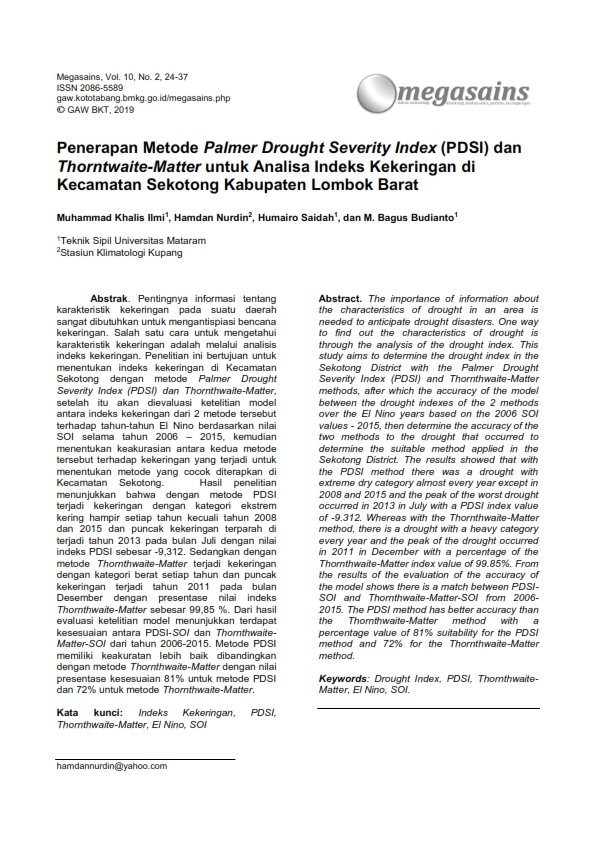Application of the Palmer Drought Severity Index (PDSI) and Thorntwaite-Matter Methods for Drought Index Analysis in Sekotong District, West Lombok Regency
Main Article Content
Abstract
The importance of information about the characteristics of drought in an area is needed to anticipate drought disasters. One way to find out the characteristics of drought is through the analysis of the drought index. This study aims to determine the drought index in the Sekotong District with the Palmer Drought Severity Index (PDSI) and Thornthwaite-Matter methods, after which the accuracy of the model between the drought indexes of the 2 methods over the El Nino years based on the 2006 SOI values - 2015, then determine the accuracy of the two methods to the drought that occurred to determine the suitable method applied in the Sekotong District. The results showed that with the PDSI method there was a drought with extreme dry category almost every year except in 2008 and 2015 and the peak of the worst drought occurred in 2013 in July with a PDSI index value of -9.312. Whereas with the Thornthwaite-Matter method, there is a drought with a heavy category every year and the peak of the drought occurred in 2011 in December with a percentage of the Thornthwaite-Matter index value of 99.85%. From the results of the evaluation of the accuracy of the model shows there is a match between PDSI- SOI and Thornthwaite-Matter-SOI from 2006-2015. The PDSI method has better accuracy than the Thornthwaite-Matter method with a percentage value of 81% suitability for the PDSI method and 72% for the Thornthwaite-Matter method
Article Details

This work is licensed under a Creative Commons Attribution-NonCommercial 4.0 International License.
The author is willing to retain the copyright and grant journal rights to the first publication with works that are simultaneously under license the Creative Commons Attribution-NonCommercial-NoDerivatives 4.0 International. It allowing the others to share the work with recognition of the author's work and the initial publication in this journal.
Authors can enter into separate additional contractual arrangements for the non-exclusive distribution of published versions of journal works (for example, posting them to institutional repositories or publishing them in a book), with recognition of the initial publications in this journal.
Authors are permitted and encouraged to send their work online (for example, in their institutional repositories or websites) before and during the submission process because it can lead to productive exchanges, as well as previous and larger citations of published works.

